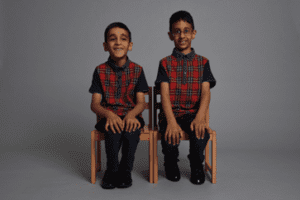
Reduced vision in young children is enormously difficult for parents or teachers to detect. Even where obvious, there is currently no mechanism to ensure vision screening results are actioned. This can leave the condition untreated throughout a child’s early school years, with potential to impact on their future educational attainment. Reception year is a decisive moment to tackle vision issues. A child’s eyesight is sufficiently developed to be meaningfully checked, and corrective glasses worn consistently can then enhance early learning.
We propose to undertake a new study ‘Glasses in Classes’ to find out if schools can support children wearing their glasses. This study investigates the impact of a school-based intervention to support the wearing of glasses in young children and measure subsequent improvement of the child’s vision and academic achievement.
Why is this project important?
Dr Alison Bruce, Director of Vision Research at the Born in Bradford programme, has investigated how poor vision can impact on literacy in aged 4-5 year olds 1 2. Essentially, failing to treat poor vision which could be treated simply by wearing glasses will hinder the child’s ability to see, preventing the child from discriminating differences in how letters appear, or see what the teacher is pointing to. While these issues can affect all children, those from disadvantaged backgrounds are more likely to go undiagnosed or miss appointments.
Indeed, approximately 10-15% of children fail an eye test in their first school year, with 4% possessing very poor vision 3. Around a third of these children failing the eye test are not taken to the opticians to obtain glasses, after at least 1 reminder 4. Parents told the research team that when schools supported them the children’s glasses wear improved 5. Parents were surprised that schools are not routinely told the results of the child’s vision screening which reduces the support available to encourage glasses wear.
Dr Alison Bruce, stated:
“Even where obvious, there is currently no mechanism to ensure vision screening results are actioned. This can leave a condition untreated throughout a child’s early school years, with known potential to impact on their future educational attainment.’
Click HERE to watch a short video by the BBC providing brief overview of the ‘Glasses in Classes’ project.
A multi-disciplinary team of researchers from the University of Leeds and the Bradford Institute for Health Research were successful to receive a grant from the Education Endowment Foundation (EEF) and the EEF have appointed the University of Nottingham as independent evaluators for the study.
Sir Kevan Collins, Chief Executive of the EEF, said:
“Making sure all young children with possible eyesight problems are identified and supported with glasses or other treatments is a clear win-win, helping improve health as well as educational opportunities.
Professor Mark Mon-Williams, lead academic from the University of Leeds, said:
“We believe this project shows great promise and could help the large number of children with visual problems across the country to have a more positive educational experience, and ensure they have the good start in life that every child deserves.”
What does the research study entail?
Parents in Bradford have told us that sharing the result of the vision screening test with both parents and schools would help support children in getting and wearing their glasses. We want to find out if sharing the results will help. We will also measure the effect of wearing glasses on the children’s vision, reading and mathematics achievements.
Primary schools in the Bradford area will be asked to take part. We aim to recruit 100 schools who will be chosen randomly to be either “Intervention” or “Control” schools.
Vision screening will continue to be offered to all children in reception class and all parents will receive the results of their child’s vision screening test as usual regardless of whether they are in the intervention or control schools. Children found to have reduced vision at vision screening will be referred for a detailed eye test. In addition, all children will have their reading and mathematics achievement measured both at the beginning and at the end of the study (school year 2019-2020). The results of these assessments are for research purposes only and will not be shared with schools or parents.
“Control Schools”: There will be no change in the vision screening process and children found to have reduced vision at screening will be referred for a detailed eye test either to the hospital or to a community optometrist (optician).
“Intervention Schools”: Following vision screening we will share the result (pass or fail) with your child’s school. In the “intervention” schools a chosen teacher known as the vision co-ordinator will follow-up children who fail the screening to find out if parents need any help e.g. with arranging optician appointments.
Children in the ‘intervention’ schools who need glasses will receive two pairs; the child’s own pair to be worn as directed by the optician (usually constantly) and a second pair which will be sent to the school. The extra pair of glasses will be kept in school. These will only be used if the child forgets to bring their own pair and will be returned to the vision co-ordinator at the end of the school day.
What happens after the Intervention?
The programme will be independently evaluated by a team from the University of Nottingham. The evaluation will use a two-arm randomised control trial to examine the impact of a one-year intervention of ‘Glasses in Classes’ on educational attainment and eyesight. The evaluation will also assess whether the intervention improved attendance for detailed testing at an optometrists (opticians) following vision screening in school and whether the children’s glasses wear improved. The evaluation report will be published in summer 2020.
If your school may be interested in joining take a look at the following link:
https://educationendowmentfoundation.org.uk/projects-and-evaluation/projects/glasses-in-classes/
References
Other References